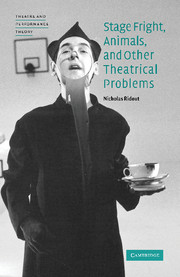1 - Stage fright: the predicament of the actor
Published online by Cambridge University Press: 04 December 2009
Summary
In an ‘awful hole’
In An Actor Prepares, Stanislavski's young persona Kostya recalls some of his first experiences of stepping on to a stage. These experiences do not of course come direct. Stanislavski's text, like Kleist's Über das Marionnettentheater and Diderot's Paradoxe sur le comédien, is a loaded dialogue, in which the author's identity is parcelled out into two characters, one knowing and one naïve. The naïveté of the naïf is always a construct of the knowingness of his interlocutor. The forms of innocence and ignorance articulated by the naïf are defined by the knowledge of the knowing. This is especially clear in the Stanislavski text, in which Kostya appears as a young version of Stanislavski, studying under the expert guidance of the elder Stanislavski, figured in the text as the Director, Tortsov. Kostya's first experiences of setting foot on stage are therefore fictionalised in order to give the best possible logical starting point for the sentimental education Stanislavski himself intends to offer. Kostya's first steps must therefore introduce the most basic problems confronting the actor. They appear under the heading ‘The First Test’. Kostya has arrived early and tries to prepare himself for the rehearsal ahead.
I went out to the front of the stage and stared into the awful hole beyond the footlights, trying to become accustomed to it, and to free myself from its pull; but the more I tried not to notice the place the more I thought about it.
The auditorium is in darkness. But the knowing Stanislavski knows what lies in the dark, even if Kostya cannot.
- Type
- Chapter
- Information
- Stage Fright, Animals, and Other Theatrical Problems , pp. 35 - 69Publisher: Cambridge University PressPrint publication year: 2006



